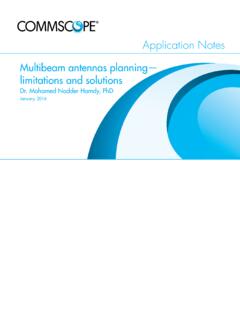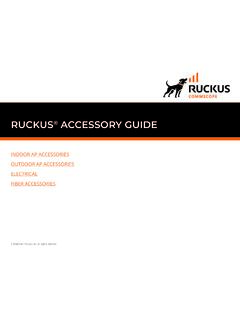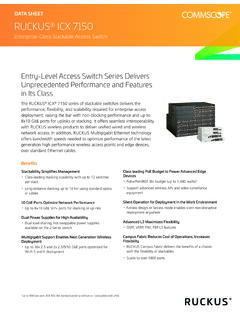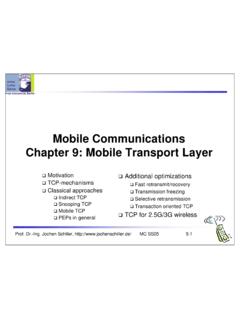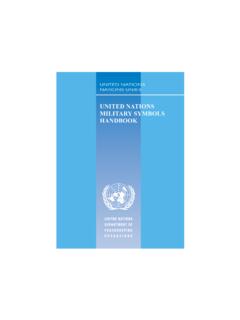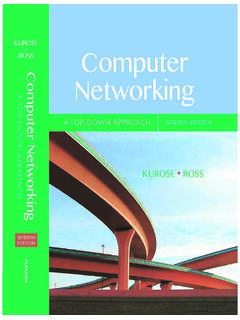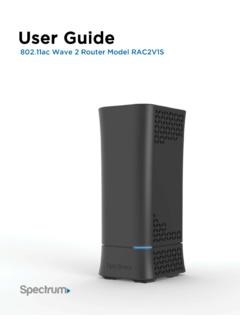Transcription of Understanding the RF path - CommScope
1 Understanding the RF path TABLE OF CONTENTS. chapter 1 Introduction: Welcome to RF communications 3. chapter 2 The solutions, practices and trends: Cell site development 8. chapter 3 Getting the signal across: Base station antennas 19. chapter 4 Working within the limits: Co-siting solutions 44. chapter 5 Talking and listening at the same time: Transmission and receiving isolation systems 59. chapter 6 Getting from the air to the network: Cables and connectivity 76. chapter 7 Clearing the connections: Overcoming passive intermodulation (PIM) 97. chapter 8 Getting the most from every cycle: Spectrum management 105. chapter 9 The infrastructure behind the call: Backhaul 115. chapter 10 The next RF architecture evolution: C-RAN 137. chapter 11 The energy of communications: Powering wireless networks 147. chapter 12 Successfully planning against failure: Reliability in wireless systems 172.
2 chapter 13 Extending the network indoors: DAS, C-RAN antenna systems, and small cell solutions 187. chapter 14 Finding safer ground: Lightning protection 196. Biographies 210 | Appendix A 214 | Glossary 219. 2. Introduction: Welcome to RF communications chapter 1. 3. Introduction: chapter 1. Welcome to RF communications Microwave backhaul The use of microwave communications to For decades, CommScope has grown up networks. It encompasses indoor wireless solutions that aggregate and transmit alongside the science of communication with allow a mobile user to find a clear connection from cellular voice and data anywhere in a vast building complex, aboard an aloft practical solutions. We have been dedicated to and from the main airliner or from a bullet train zipping through a tunnel to helping the world achieve more powerful, under miles of granite. It even includes transmissions network.
3 Efficient and innovative ways to network in the microwave bands, which, as you will learn, are information and people. We have partnered an effective way to move vast amounts of data miles with leading networks all over the world to across a network without cable. help them maximize opportunities and unlock Indeed, as established a science as RF is, there remains hidden potential, because we believe in the incredible potential for new and innovative solutions that expand its reach and usefulness across every power of innovative networks and those aspect of modern life. CommScope is dedicated to who build them. unlocking this potential. To us, true partnership also includes sharing what The goal of this book is to explore the many dimensions we've learned along the way. The result is this book, of RF communications past, present and future. It will which presents the fundamentals of radio frequency also examine the technologies, solutions and practices (RF) communications in a comprehensive, yet that power the ongoing evolution of RF's role in the approachable, way.
4 World, including many innovative technologies and practices that CommScope has brought to the industry. Many different kinds of communication rely wholly Some of this material is theoretical and technical, but or in part on RF technologies. The field is not limited every effort has been made to keep it as approachable to long-established applications like broadcast radio, as possible. Consider this RF Fundamentals 101. shortwave and so forth it also includes modern cellular communications such as 4G/LTE and emerging 5G. BACK TO TABLE OF CONTENTS. 4. 1 | Introduction: Welcome to RF communications RF systems, then and now show how they interweave to create the fabric of Wireless communication is a mature science. RF systems modern communications. These systems include such have been in commercial use since the 1940s, with the components as: earliest examples including community repeaters, paging systems, point-to-point links and specialized mobile radio Antennas, which are the structures where radio signals enter and exit (trunked) systems.
5 The air More recent innovations and uses of the RF spectrum include the cellular radio networks we are all now Coaxial copper cable, which features an inner and outer conductive familiar with. These applications originated in the 1980s layer for signals to travel and have evolved into a diverse and dynamic ecosystem Fiber-optic cable, which uses pulses of light to transmit information of technologies, standards and architectures. Alongside efficiently these applications, other wireless technologies have become mainstream, even common features of everyday Filters, which prevent the intrusion of interfering signals from entering life Wi-Fi, for example. the RF path The shared link Amplifiers, which increase signal transmission power to extend These diverse applications all share one important distance or improve signal quality characteristic: they all utilize a limited range of radio Enclosures, located at the base of a cell site, connected to remote frequencies to move information between radio base radios and antennas at the top locations and remote users.
6 The chain of components required to make this Power backups, which ensure uninterrupted wireless service in the movement of information possible is complex and event of grid power failure diverse. CommScope 's wide range of solutions allows us to present a fairly comprehensive view This is only a partial list, but this book will explore these of these systems, explain how they function and and other components in the chapters ahead. BACK TO TABLE OF CONTENTS. 5. 1 | Introduction: Welcome to RF communications RF communications: The early years frequencies within its coverage area. Voice and data calls While the full story of RF communications continues could be seamlessly handed off to neighboring cells to be written by a dynamic, growing industry, the as the user moved from one coverage area or cell to current capabilities of modern RF technologies would the next.
7 The close-proximity reuse of radio channels is the fundamental concept of cellular telephones, and 42% DATA TRAFFIC GROWTH. almost certainly exceed the wildest dreams of the field's earliest pioneers. We take our connected world for even today, it remains the reason why wireless networks granted, but the earliest commercial uses were not nearly can move vast amounts of traffic within a comparatively so ubiquitous. narrow band of RF spectrum. Data Traffic The first RF systems featured a base radio using an The business case for technical expertise omnidirectional antenna to communicate with one or Wireless service providers monitor key performance more mobile users. Then, as now, the effective coverage indicators within their territories to identify coverage 2016 2017 2018 2019 2020 2021. radius of that base radio was limited by factors including problems and assure customer satisfaction.
8 These 42% data traffic CAGR growth each year through 2021, worldwide RF power, antenna height, and the sensitivity of mobile indicators include quality of service (QoS), dropped calls, receivers that were vulnerable to thermal noise and other failed access attempts, and other criteria. Their engineers SOURCE: Ericsson Mobility Report, June 2017. interference sources. These systems were also limited by are on the front lines of this battle for quality and the fact that certain frequencies could only be used once constantly optimizing network performance as traffic in a particular geographical area. Once a mobile user left grows at an incredible rate. that area, no communication was possible. Of the many ways an RF engineer can optimize a The engineers of AT&T Bell Laboratories envisioned a network, the first and most essential is to ensure a solid future that would require much higher RF capacities physical foundation of interoperating components across to service thousands or millions of users at once.
9 To the RF path (Figure ). deliver this future, they developed the cellular concept: a wireless network that uses lower antenna heights and transmission power levels to create limited- radius coverage areas that used and reused the same BACK TO TABLE OF CONTENTS. 6. 1 | Introduction: Welcome to RF communications Not only does this foundation provide the best scenario for efficient operation, it also helps minimize the likelihood of downtime, which is a disruptive and expensive proposition for the wireless service operator. For these reasons, it's vital for the RF engineer to understand the latest standards and specifications, and to choose components that meet or exceed those standards and specifications. It is an unfortunate fact Self- in the wireless industry that not all solutions are built optimizing Have a quality life experience networks while on the network to meet the latest requirements it is incumbent on Advanced fine the provider and the engineer to ensure compliant tuning components are used in the RF path .
10 Handoff parameters Stay on the network Understanding the RF path and the parts that make it operate efficiently is the journey this book will follow. Access parameters CommScope is glad to have you join us for the trip. Let's Get on the network visit the first stop along the way in the next chapter , Physical layer RF path where we will examine the makeup of a modern cell site. Coverage design : The interconnection of technology, design and optimization BACK TO TABLE OF CONTENTS. 7. The solutions, practices and trends: Cell site development chapter 2. 8. The solutions, practices and trends: chapter 2. Cell site development Macro cell sites Large, conventional, standalone Building a new cell site or upgrading an Macro or metro? Know the difference. cell sites that occupy a existing site raises some of the same First and foremost, you need to know how the site will dedicated space.


